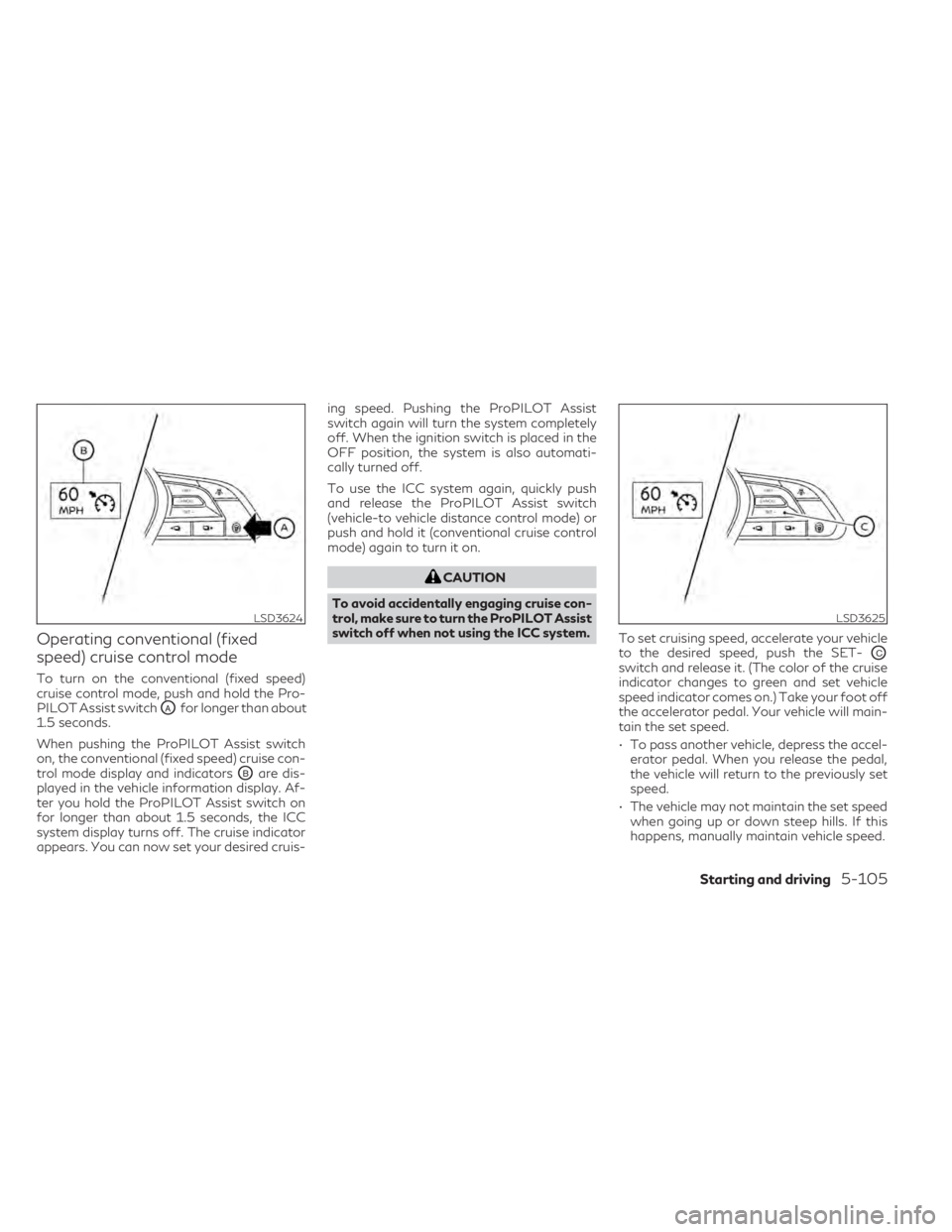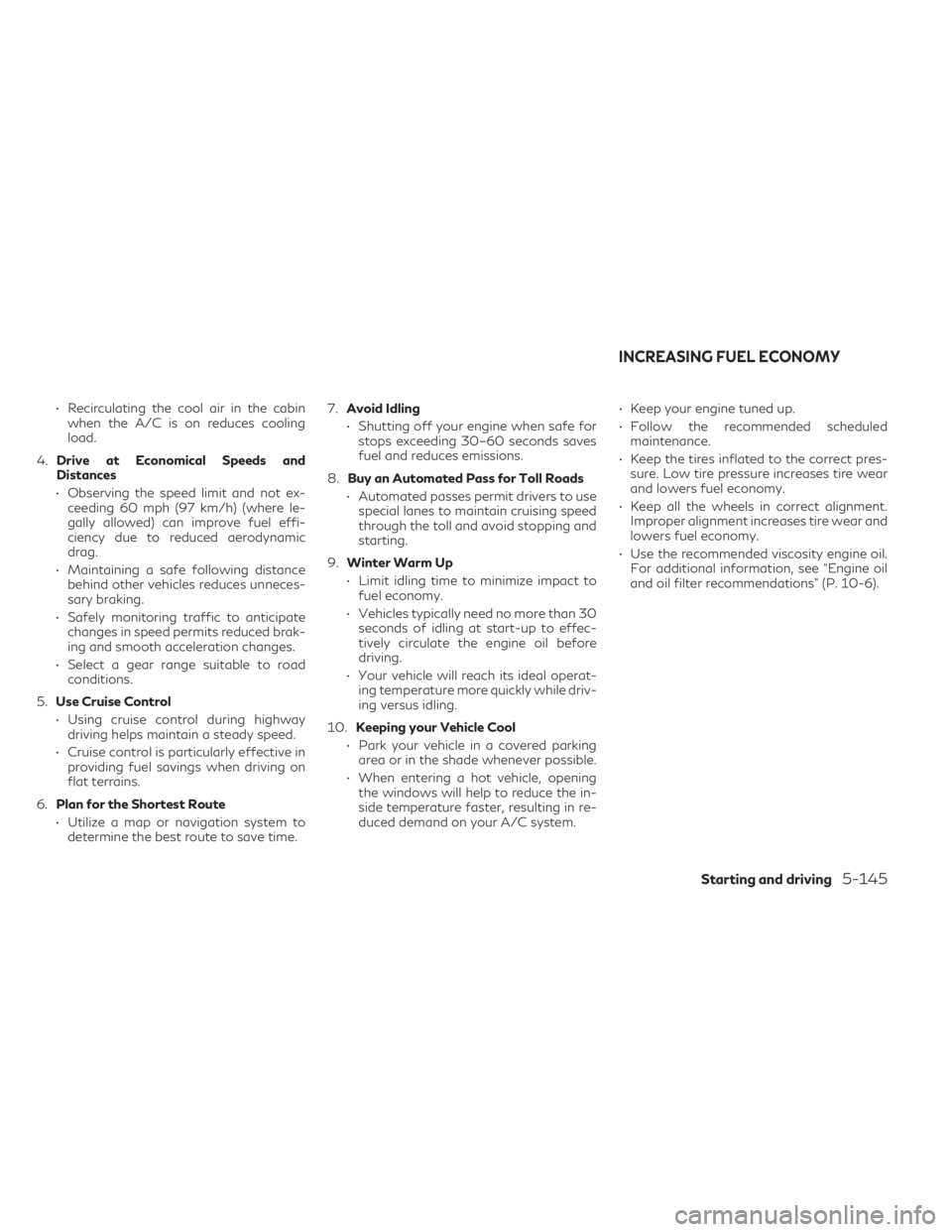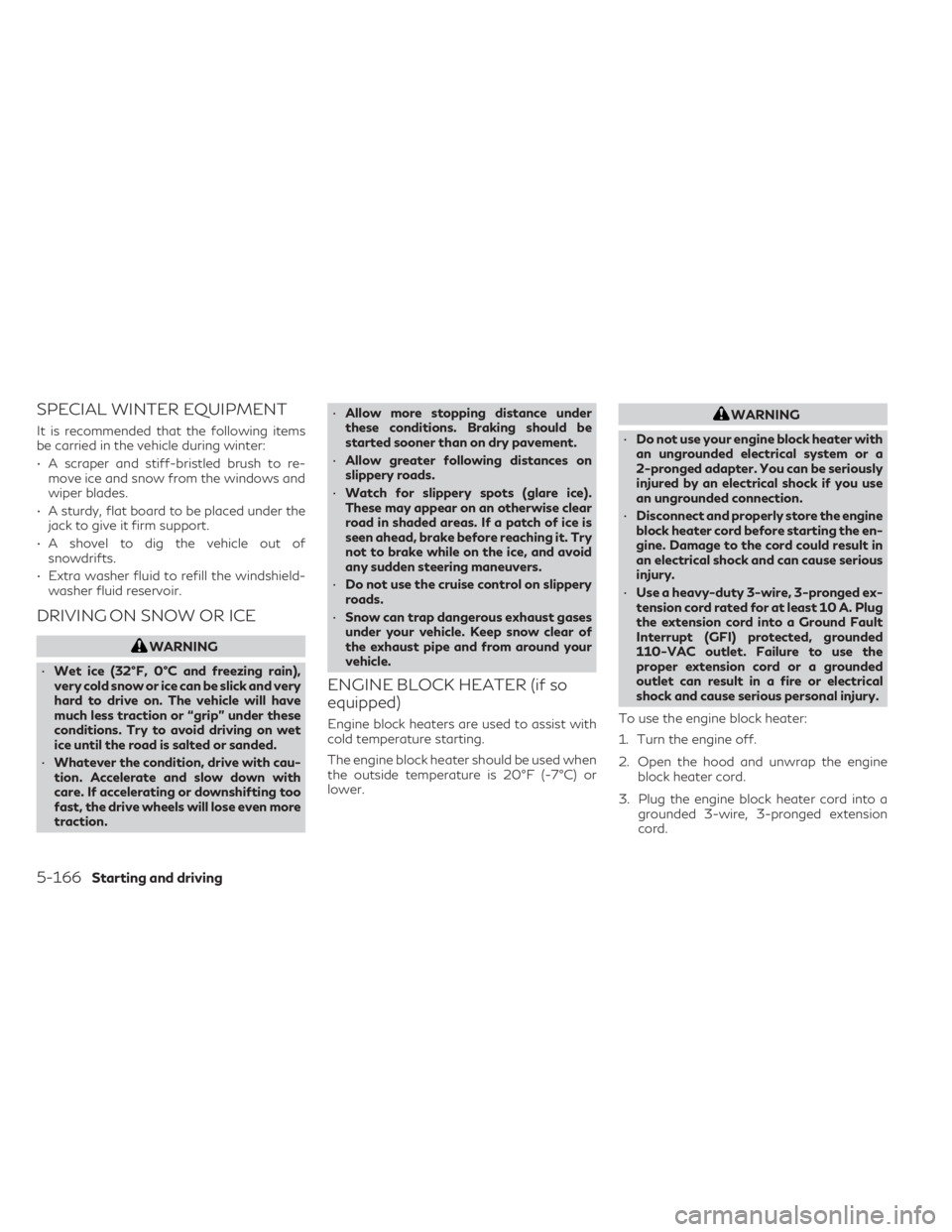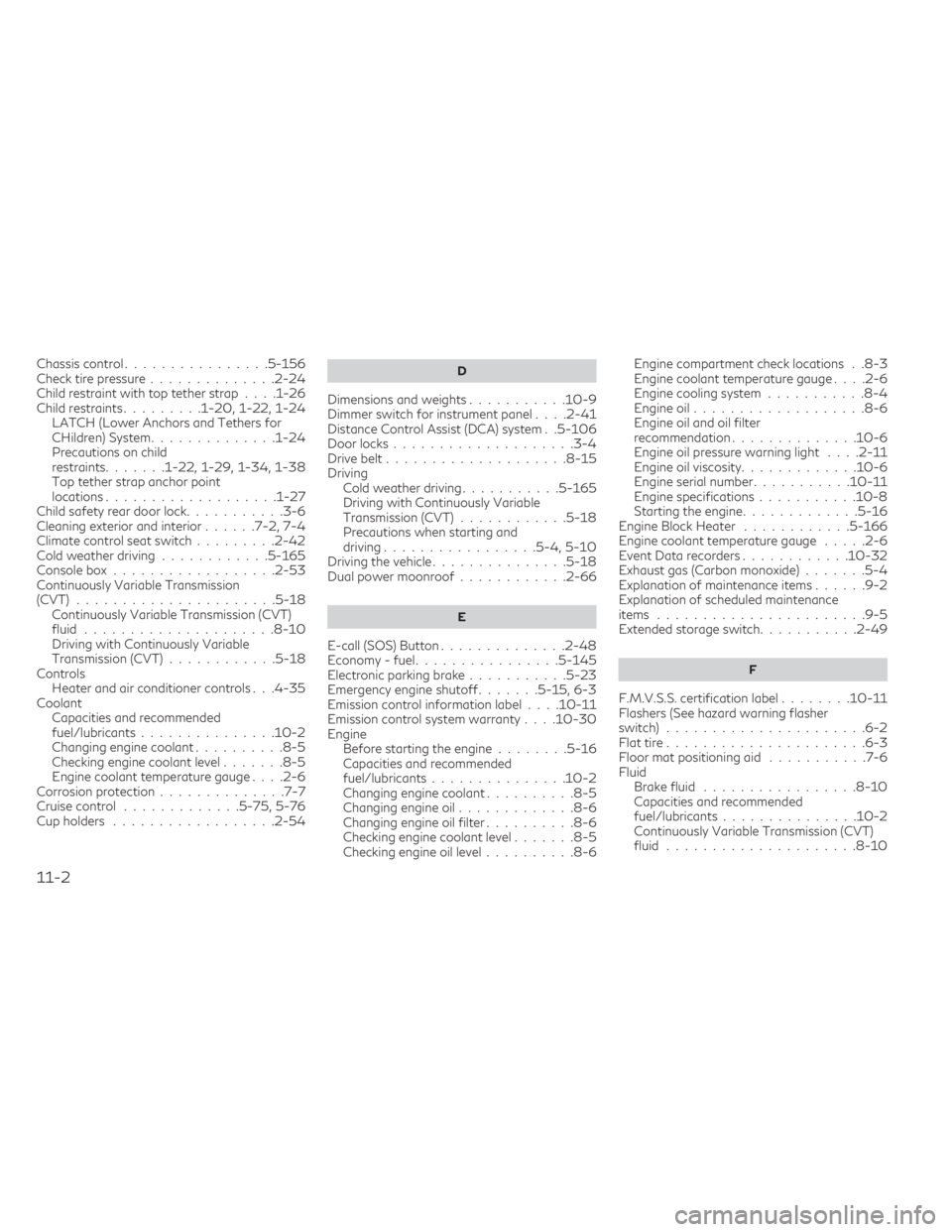cruise control INFINITI QX50 2021 Owner's Guide
[x] Cancel search | Manufacturer: INFINITI, Model Year: 2021, Model line: QX50, Model: INFINITI QX50 2021Pages: 542, PDF Size: 3.51 MB
Page 347 of 542

Operating conventional (fixed
speed) cruise control mode
To turn on the conventional (fixed speed)
cruise control mode, push and hold the Pro-
PILOT Assist switch
OAfor longer than about
1.5 seconds.
When pushing the ProPILOT Assist switch
on, the conventional (fixed speed) cruise con-
trol mode display and indicators
OBare dis-
played in the vehicle information display. Af-
ter you hold the ProPILOT Assist switch on
for longer than about 1.5 seconds, the ICC
system display turns off. The cruise indicator
appears. You can now set your desired cruis- ing speed. Pushing the ProPILOT Assist
switch again will turn the system completely
off. When the ignition switch is placed in the
OFF position, the system is also automati-
cally turned off.
To use the ICC system again, quickly push
and release the ProPILOT Assist switch
(vehicle-to vehicle distance control mode) or
push and hold it (conventional cruise control
mode) again to turn it on.
CAUTION
To avoid accidentally engaging cruise con-
trol, make sure to turn the ProPILOT Assist
switch off when not using the ICC system. To set cruising speed, accelerate your vehicle
to the desired speed, push the SET-
OCswitch and release it. (The color of the cruise
indicator changes to green and set vehicle
speed indicator comes on.) Take your foot off
the accelerator pedal. Your vehicle will main-
tain the set speed.
• To pass another vehicle, depress the accel-
erator pedal. When you release the pedal,
the vehicle will return to the previously set
speed.
• The vehicle may not maintain the set speed when going up or down steep hills. If this
happens, manually maintain vehicle speed.
LSD3624LSD3625
Starting and driving5-105
Page 348 of 542

To cancel the preset speed, use any of the
following methods:
1. Push the CANCEL switch. The vehiclespeed indicator will turn off.
2. Tap the brake pedal. The vehicle speed indicator will turn off.
3. Turn the ProPILOT Assist switch off. Both the cruise indicator and vehicle
speed indicator will turn off.
To reset at a faster cruising speed, use one of
the following three methods:
1. Depress the accelerator pedal. When the vehicle attains the desired speed, push
and release the SET- switch.
2. Push and hold the RES+ switch. When the vehicle attains the desired speed, release
the switch.
3. Push, then quickly release the RES+ switch. Each time you do this, the set
speed will increase by about 1 mph (1
km/h).
To reset at a slower cruising speed, use one
of the following three methods:
1. Lightly tap the brake pedal. When the ve- hicle attains the desired speed, push the
SET- switch and release it. 2. Push and hold the SET- switch. Release
the switch when the vehicle slows down
to the desired speed.
3. Push, then quickly release the SET- switch. Each time you do this, the set
speed will decrease by about 1 mph (1
km/h).
To resume the preset speed, push and release
the RES+ switch. The vehicle will resume the
last set cruising speed when the vehicle speed
is over 25 mph (40 km/h).WARNING
Failure to follow the warnings and instruc-
tions for proper use of the DCA system
could result in serious injury or death.
• Always drive carefully and attentively
when using the DCA system. Read and
understand the Owner’s Manual thor-
oughly before using the DCA system. To
avoid serious injury or death, do not rely
on the system to prevent accidents or to
control the vehicle’s speed in emergency
situations. Do not use the DCA system
except in appropriate road and traffic
conditions.
• The system is only an aid to assist the
driver and is not a collision warning or
avoidance device. It is the driver’s re-
sponsibility to stay alert, drive safely and
be in control of the vehicle at all times.
DISTANCE CONTROL ASSIST (DCA)
(if so equipped)
5-106Starting and driving
Page 359 of 542

If it is not possible to set the system or the
indicator stays on, it may indicate that the
system is malfunctioning. Although the ve-
hicle is still drivable under normal conditions,
have the vehicle checked. It is recommended
that you visit an INFINITI retailer for this
service
SYSTEM MAINTENANCE
The sensor for the DCA system is common
with ICC and is located behind the front
bumper.
For additional information, see “Intelligent
Cruise Control (ICC) (for vehicles with ProPI-
LOT Assist)” (P. 5-87).
For USA/Canada
Model: ARS4–A
IC: 4135A-ARS4A
FCC ID: OAYARS4A
This device complies with Part 15 of the FCC
Rules and with Industry Canada licence-
exempt RSS standard(s). Operation is subject
to the following two conditions: (1) This de-
vice may not cause interference, and (2) this
device must accept any interference, includ-
ing interference that may cause undesired
operation of the device.Le présent appareil est conforme aux CNR
d'Industrie Canada applicables aux appareils
radio exempts de licence. L'exploitation est
autorisée aux deux conditions suivantes: (1)
L'appareil ne doit pas produire de brouillage,
et (2) l'utilisateur de l'appareil doit accepter
tout brouillage radioélectrique subi, même si
le brouillage est susceptible d'en comprom-
ettre le fonctionnement.
Radio Frequency Radiation Exposure
Information:
This equipment complies with FCC and IC
radiation exposure limits set forth for an un-
controlled environment.
This equipment should be installed and oper-
ated with minimum distance of 30 cm be-
tween the radiator and your body.
This transmitter must not be co-located or
operating in conjunction with any other an-
tenna or transmitter.
Cet équipment est conforme aux limites
d’exposition aux rayonnements IC établies
pour un environnement non contrôlé. Cet
équipment doit étre installé et utilisé avec un
minimum de 30 cm de distance entre la
source de rayonnement et votre corps.
FCC Notice
Changes or modifications not expressly ap-
proved by the party responsible for compli-
ance could void the user’s authority to oper-
ate the equipment.
Starting and driving5-117
Page 387 of 542

• Recirculating the cool air in the cabinwhen the A/C is on reduces cooling
load.
4. Drive at Economical Speeds and
Distances
• Observing the speed limit and not ex- ceeding 60 mph (97 km/h) (where le-
gally allowed) can improve fuel effi-
ciency due to reduced aerodynamic
drag.
• Maintaining a safe following distance behind other vehicles reduces unneces-
sary braking.
• Safely monitoring traffic to anticipate changes in speed permits reduced brak-
ing and smooth acceleration changes.
• Select a gear range suitable to road conditions.
5. Use Cruise Control
• Using cruise control during highway driving helps maintain a steady speed.
• Cruise control is particularly effective in providing fuel savings when driving on
flat terrains.
6. Plan for the Shortest Route
• Utilize a map or navigation system to determine the best route to save time. 7.
Avoid Idling
• Shutting off your engine when safe for stops exceeding 30–60 seconds saves
fuel and reduces emissions.
8. Buy an Automated Pass for Toll Roads
• Automated passes permit drivers to use special lanes to maintain cruising speed
through the toll and avoid stopping and
starting.
9. Winter Warm Up
• Limit idling time to minimize impact to fuel economy.
• Vehicles typically need no more than 30 seconds of idling at start-up to effec-
tively circulate the engine oil before
driving.
• Your vehicle will reach its ideal operat- ing temperature more quickly while driv-
ing versus idling.
10. Keeping your Vehicle Cool
• Park your vehicle in a covered parking area or in the shade whenever possible.
• When entering a hot vehicle, opening the windows will help to reduce the in-
side temperature faster, resulting in re-
duced demand on your A/C system. • Keep your engine tuned up.
• Follow the recommended scheduled
maintenance.
• Keep the tires inflated to the correct pres- sure. Low tire pressure increases tire wear
and lowers fuel economy.
• Keep all the wheels in correct alignment. Improper alignment increases tire wear and
lowers fuel economy.
• Use the recommended viscosity engine oil. For additional information, see “Engine oil
and oil filter recommendations” (P. 10-6).
INCREASING FUEL ECONOMY
Starting and driving5-145
Page 408 of 542

SPECIAL WINTER EQUIPMENT
It is recommended that the following items
be carried in the vehicle during winter:
• A scraper and stiff-bristled brush to re-move ice and snow from the windows and
wiper blades.
• A sturdy, flat board to be placed under the jack to give it firm support.
• A shovel to dig the vehicle out of snowdrifts.
• Extra washer fluid to refill the windshield- washer fluid reservoir.
DRIVING ON SNOW OR ICE
WARNING
• Wet ice (32°F, 0°C and freezing rain),
very cold snow or ice can be slick and very
hard to drive on. The vehicle will have
much less traction or “grip” under these
conditions. Try to avoid driving on wet
ice until the road is salted or sanded.
• Whatever the condition, drive with cau-
tion. Accelerate and slow down with
care. If accelerating or downshifting too
fast, the drive wheels will lose even more
traction. •
Allow more stopping distance under
these conditions. Braking should be
started sooner than on dry pavement.
• Allow greater following distances on
slippery roads.
• Watch for slippery spots (glare ice).
These may appear on an otherwise clear
road in shaded areas. If a patch of ice is
seen ahead, brake before reaching it. Try
not to brake while on the ice, and avoid
any sudden steering maneuvers.
• Do not use the cruise control on slippery
roads.
• Snow can trap dangerous exhaust gases
under your vehicle. Keep snow clear of
the exhaust pipe and from around your
vehicle.
ENGINE BLOCK HEATER (if so
equipped)
Engine block heaters are used to assist with
cold temperature starting.
The engine block heater should be used when
the outside temperature is 20°F (-7°C) or
lower.
WARNING
• Do not use your engine block heater with
an ungrounded electrical system or a
2-pronged adapter. You can be seriously
injured by an electrical shock if you use
an ungrounded connection.
• Disconnect and properly store the engine
block heater cord before starting the en-
gine. Damage to the cord could result in
an electrical shock and can cause serious
injury.
• Use a heavy-duty 3-wire, 3-pronged ex-
tension cord rated for at least 10 A. Plug
the extension cord into a Ground Fault
Interrupt (GFI) protected, grounded
110-VAC outlet. Failure to use the
proper extension cord or a grounded
outlet can result in a fire or electrical
shock and cause serious personal injury.
To use the engine block heater:
1. Turn the engine off.
2. Open the hood and unwrap the engine block heater cord.
3. Plug the engine block heater cord into a grounded 3-wire, 3-pronged extension
cord.
5-166Starting and driving
Page 532 of 542

Chassis control................5-156Check tire pressure..............2-24Child restraint with top tether strap. . . .1-26Child restraints.........1-20, 1-22, 1-24LATCH (Lower Anchors and Tethers for
CHildren) System..............1-24Precautions on child
restraints.......1-22, 1-29, 1-34, 1-38Top tether strap anchor point
locations.................. .1-27Child safety rear door lock...........3-6Cleaning exterior and interior......7-2, 7-4Climate control seat switch.........2-42Cold weather driving........... .5-165Console box................. .2-53Continuously Variable Transmission
(CVT)..................... .5-18Continuously Variable Transmission (CVT)
fluid.....................8-10Driving with Continuously Variable
Transmission (CVT)............5-18Controls
Heater and air conditioner controls. . .4-35CoolantCapacities and recommended
fuel/lubricants
.............. .10-2Changing engine coolant..........8-5Checking engine coolant level.......8-5Engine coolant temperature gauge. . . .2-6Corrosion protection..............7-7Cruise control.............5-75, 5-76Cup holders................. .2-54
D
Dimensions and weights...........10-9Dimmer switch for instrument panel. . . .2-41Distance Control Assist (DCA) system. .5-106Door locks................... .3-4Drive belt....................8-15Driving
Cold weather driving.......... .5-165Driving with Continuously Variable
Transmission (CVT)........... .5-18Precautions when starting and
driving................ .5-4, 5-10Driving the vehicle...............5-18Dual power moonroof............2-66
E
E-call (SOS) Button............. .2-48Economy - fuel............... .5-145Electronic parking brake...........5-23Emergency engine shutoff.......5-15, 6-3Emission control information label. . . .10-11Emission control system warranty. . . .10-30Engine
Before starting the engine........5-16Capacities and recommended
fuel/lubricants.............. .10-2Changing engine coolant..........8-5Changing engine oil.............8-6Changing engine oil filter..........8-6Checking engine coolant level.......8-5Checking engine oil level..........8-6
Engine compartment check locations. .8-3Engine coolant temperature gauge. . . .2-6Engine cooling system...........8-4Engine oil.................. .8-6Engine oil and oil filter
recommendation..............10-6Engine oil pressure warning light. . . .2-11Engine oil viscosity.............10-6Engine serial number...........10-11Engine specifications...........10-8Starting the engine............ .5-16Engine Block Heater............5-166Engine coolant temperature gauge. . . . .2-6Event Data recorders............10-32Exhaust gas (Carbon monoxide).......5-4Explanation of maintenance items......9-2Explanation of scheduled maintenance
items...................... .9-5Extended storage switch...........2-49
F
F.M.V.S.S. certification label........10-11Flashers (See hazard warning flasher
switch)..................... .6-2Flat tire......................6-3Floor mat positioning aid...........7-6Fluid
Brake fluid................ .8-10Capacities and recommended
fuel/lubricants...............10-2Continuously Variable Transmission (CVT)
fluid.................... .8-10
11-2
Page 533 of 542

Engine coolant................8-4Engine oil.................. .8-6Windshield-washer fluid.........8-11Fog light switch................2-42Forward Emergency Braking (FEB) with
Pedestrian Detection system. . .2-13, 5-123Front air bag system
(See supplemental restraint system). . . .1-48Front and rear sonar system........5-160Front and rear sonar system switch. . . .2-45Front power seat adjustment.........1-3Front seats................... .1-2Front-door pocket..............2-50Fuel
Capacities and recommended
fuel/lubricants
.............. .10-2Fuel economy...............5-145Fuel gauge................. .2-7Fuel octane rating.............10-5Fuel recommendation...........10-3Fuel-filler door and cap..........3-28Loose fuel cap warning..........2-22Fuel efficient driving tips..........5-144Fuel gauge................... .2-7Fuel-filler door.................3-28Fuses..................... .8-20Fusible links..................8-21
G
Garage door opener, HomeLink® Universal
Transceiver.......2-70, 2-72, 2-73, 2-74Gas cap.................... .3-28
Gauge
Engine coolant temperature gauge. . . .2-6Fuel gauge................. .2-7Odometer.................. .2-5Speedometer.................2-5Tachometer................. .2-6Trip odometer................2-5General maintenance..............9-2Glove box................... .2-52Glove box lock.................2-52Grocery hooks.................2-56
H
Hazard warning flasher switch........6-2Head restraints.................1-7Head Up Display (HUD)...........2-46Headlight aiming control...........2-40Headlight and turn signal switch......2-36Headlight switch.............. .2-36Headlights.................. .8-24Headlights, aiming control..........2-40Heated seats..................2-43Heater
Heater and air conditioner (automatic)
(if so equipped)
.............. .4-34Heater and air conditioner controls. . .4-35Heater operation..............4-36Heater and air conditioner (automatic). .4-34Heater and air conditioner settings.....4-41Hill start assist system...........5-159HomeLink® Universal
Transceiver.......2-70, 2-72, 2-73, 2-74
Hood..................... .3-21Hook
Luggage hook.............. .2-55Horn...................... .2-42
I
Ignition switch
Push-button ignition switch.......5-13Immobilizer system............. .5-16Important vehicle information label. . . .10-11In-cabin microfilter..............8-16Increasing fuel economy..........5-145Indicator lights and audible reminders
(See warning/indicator lights and audible
reminders)
............... .2-9, 2-10INFINITI Drive Mode Selector.......5-28INFINITI Intelligent Key System. . . .3-2, 3-6INFINITI InTouch™ Owner's Manual. . . .4-2INFINITI Vehicle Immobilizer
System..............2-30, 3-4, 5-16Inside automatic anti-glare mirror. . . . .3-34Instrument brightness control........2-41Instrument panel.............0-6, 2-2Instrument panel dimmer switch......2-41Intelligent All-Wheel Drive (AWD). . . .5-146Intelligent Cruise Control (ICC)
(for vehicles with ProPILOT Assist). . . .5-87Intelligent Key system
Key operating range............ .3-8Key operation............... .3-9Mechanical key................3-3Remote keyless entry operation.....3-13
11-3